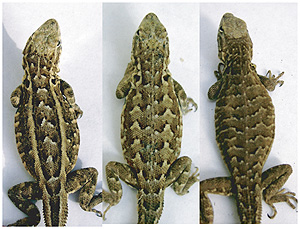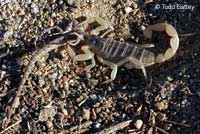Post by Ceratodromeus on Jun 5, 2015 1:15:51 GMT 5
d.jpg)
Scientific classification:
Kingdom: Animalia
Phylum: Chordata
Subphylum: Vertebrata
Class: Reptilia
Order: Squamata
Suborder: Lacertilia
Family: Phrynosomatidae
Genus: Uta
Subspecies list:
U. s. elegans - Western Side-blotched Lizard
U. s. nevadensis - Nevada Side-blotched Lizard
U. s. stansburiana - Northern Side-blotched Lizard
U. s. stejnegeri - Eastern Side-blotched Lizard
U. s. uniformis - Plateau Side-blotched Lizard
Description:
U. stansburiana is a small desert dwelling lizard. They range from 43-64mm(1.6- 2.5in){1} in Snout-to-vent length. Sexual dimorphism is moderately present, with males generally only reaching marginally larger sizes then the females, though they do have proportionately larger heads. These lizards are characterized by the large dark spot located behind their front forelimbs. Patterning depends on locale, but standard coloration is a dark brown with various black and white speckling. When mating season occurs, males take on shades of orange, blues, yellows, and reds.

Black "splotch" that gives these lizards their common name

Pattern variation in the species
Geographic range & Habitat:
This lizard can be found throughout most of the southwestern United States. They are commonly found inhabiting rocky outcrops and grasslands. Where they occur in arid areas, they can commonly be found under sagebrush.

Dietary habits:
The side blotched lizard is an oppurtunistic feeder, feeding on a variety of insects (predominately members of Coleoptera & Orthoptera) and Arachnids, ants also play a significant role in the diet of the side blotched lizard{2}. Smaller lizards have also been noted as prey animals, and plant matter has also been documented. They are sit-and-wait predators, often perching on rocks or logs and surveying the ground for possible prey items.
Predators:
Being as small as this lizard is, it is rather low on the food chain. Scorpions, large spiders, Snakes (masticophis, Crotalus, Arizona) Lizards( Crotaphytus, Gambelia, Aspidoscelis), Roadrunners and Burrowing owls have all been documented in taking side blotched lizards. Corvids, accipiterids, Young king & bullsnakes all are potential predators.{1} The side-blotched lizard can automotize(cast-off) its tail in order to distract predators, and subsequently make its escape.

Beind so dimunitive, the side blotched lizard is a frequent prey item in the diet of predators it's sympatric with. Here, a desert scorpion feeds on a small individual.
Reproduction:
Follicle growth begins in the early Spring, with reproduction occuring up until August. Eggs are laid in the early summer, with the female depositing as many as 6 eggs(typical clutch size is four) in sandy substrate. Reproductive females can lay as many as three clutches in one season. Typical incubation periods for U. stansburiana last 60 days. Hatchlings grow slowly for their first weeks of life, Sexually maturing at around four months of age.{2}
References:
{1}Parker, William S., and Eric R. Pianka. "Comparative ecology of populations of the lizard Uta stansburiana." Copeia (1975): 615-632.
{2}Tinkle, Donald W. "The life and demography of the side-blotched lizard, Uta stansburiana." (1967).


